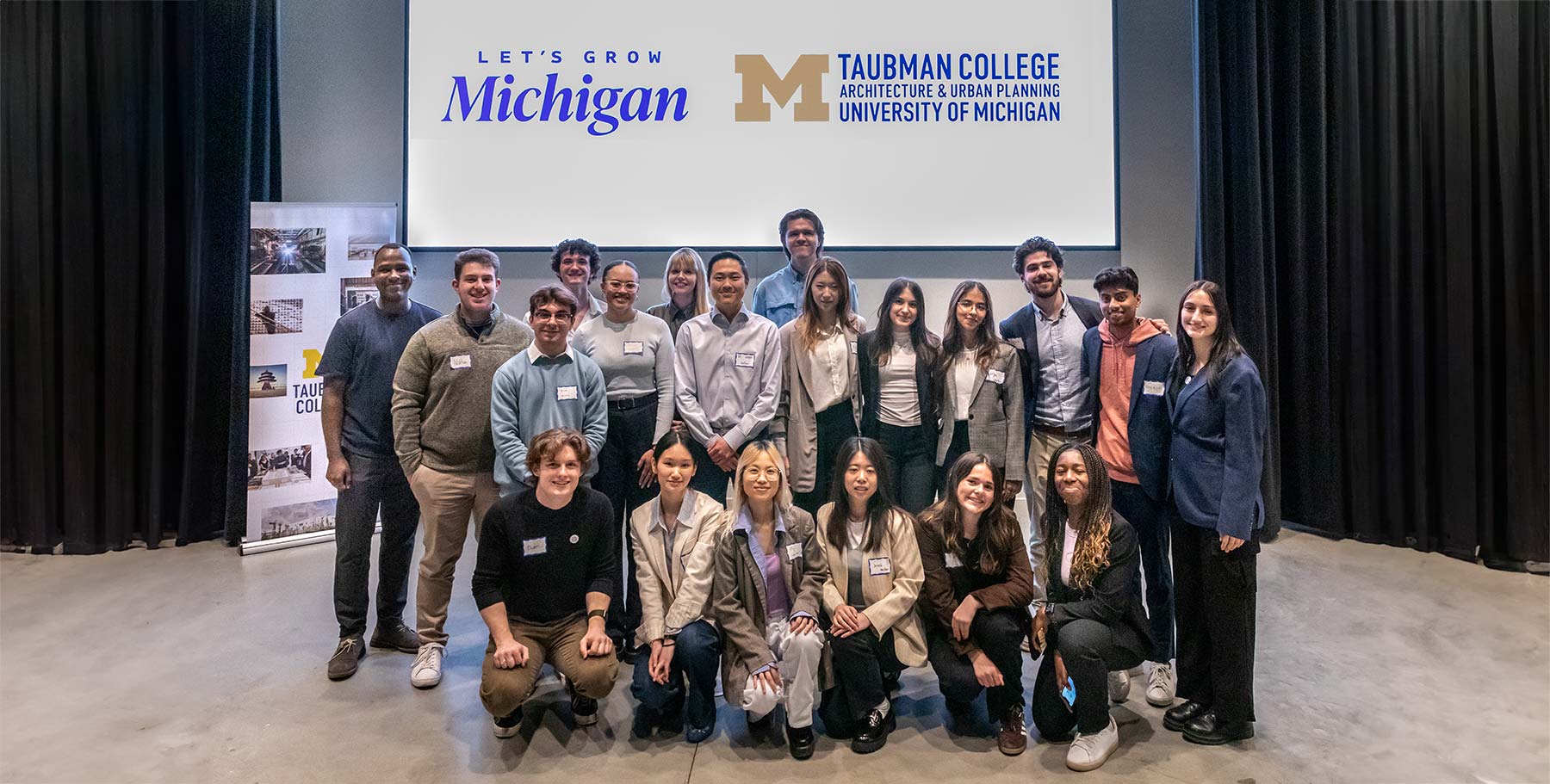Borum and Daubmann awarded Metalmag Architectural Award
Professor Craig Borum and Associate Professor of Architecture Karl Daubmann were selected as one of the winners of the 2011 Metalmag Architectural Awards in the Interiors category for work on Ayaka Japanese Restaurant in Ann Arbor, Mich. The awards competition honors the best in metal design and construction. PLY Architecture, of which Borum and Daubmann are principals, was the architect, installer and manufacturer of the project – a 3D-suspended ceiling out of aluminum to create a look that resembles the symmetrical gills of a manta ray. Laser cutting was used to trim the metal.
According to a program judge, Jason Wright, associate with Hickok Cole Architects in Washington, D.C., “‘The simple folded metal ceiling in this design really provided a solid concept for this space and allowed one gesture to make a statement. The unique folding and shaping of the material also was impressive.'”
To read the article online and view a slide show:
www.metalmag.com/walls-and-ceilings/aluminum-goes-aquatic.aspx
Shared from metalmag September 2011, posted on September 6, 2011 “Aluminum Goes Aquatic: Ayaka Sushi’s Ceiling Design Breaks the Mold”
By Sabrina Grotewold
Customizing a 3D suspended ceiling out of 0.04-inch-thick, powder-coated aluminum strips was no easy task. The challenge was to create a look that resembles the symmetrical gills of a manta ray for Ayaka Sushi, a Japanese restaurant located in the college town of Ann Arbor, Mich. Local architect and University of Michigan Taubman College of Architecture associate professor Karl Daubmann accepted the challenge, even though he admits that at the time, he wasn’t entirely sure he could pull off.
Daubmann and his team at Ann Arbor-based PLY Architecture had worked with aluminum in unique ways before. They have bent and laser-cut metal to form lively shapes like the conical Shadow Pavilion at the University of Michigan (profiled in the November/December 2010 issue of Metalmag) or the scarlet red interwoven laser-cut wall surface at BTB Cantina in Ann Arbor. Still, truly breaking the mold requires experimentation. “We don’t like doing the same thing over and over again,” Daubmann explains. “While we’ve worked with aluminum before, with every new project we try to push and see what we can come up with next. We use our experience to think further.”
Like an ethereal manta ray drifting in the ocean, the suspended-ceiling design and the way lamps drop down from the structure gives diners the impression of being under¬water with a sea creature looming overhead. This bold, thoughtful design and creative manipulation of aluminum helped earn the restaurant top honors in the Interiors category of the 2011 Metalmag Architectural Awards.
“The simple folded metal ceiling in this design really provided a solid concept for this space and allowed one gesture to make a statement,” says Jason Wright, associate with Hickok Cole Architects, Washington, D.C., and a judge for this year’s awards program. “The unique folding and shaping of the material also was impressive.”
“We have seen all too many restaurants cluttered with images and various materials that try to make a literal attempt [to depict] what is on the menu,” says juror Tim Wurtele, architect with Omaha, Neb.-based design firm HDR. “These designs can be so in your face and obvious that they tend to disappear and become very thoughtless. Ayaki Sushi is the opposite of that.”
Bend It
Figuring out the geometry of the ceiling and determining how malleable the metal could be were the first steps. Turning the design concept into reality began with an origami project, which was rather fitting for the construction of a Japanese restaurant. The architects folded paper at their desks as a zero-risk geometry test, modeled the origami digitally and then considered the variables. A mock-up was performed using different alloys and thickness of aluminum to see which combination would bend in the appropriate ways. Once the aluminum was selected, a local laser cutter trimmed the metal into sheets. Instead of using a sheet metal bender that will only accept unbent material, each sheet was laser cut with a dashed line, similar to perforated lines on paper.
“To save money, we were able to avoid using specialty folding and use laser cutting instead because [the ceiling structure] is symmetrical,” Daubmann explains. “From the front to the back of the restaurant, every piece is unique, but from left to right, each piece is the mirror image of the other. So with the laser cutting, we could cut two of every piece and fold it up or down, depending on which side it would go.”
The team bent each of the strips by hand. The aluminum strips, which are about 6 to 8 inches wide, were folded along the dashed laser-cut line and riveted into six subsections of five to six individual 5-foot-by-10-foot bands. “The biggest thing we learned about the aluminum we used was that we could bend it by hand and get it to be very precise because there were stops built into it,” Daubmann says. “Even if you bent the aluminum too much or not enough, because all of the pieces lined up, it was self-regulating.”
The subsections were predrilled and fitted together in the shop before being delivered to the restaurant for installation. According to Daubmann, the hardest part was getting the structure to be perfectly level. Daubmann likes aluminum for custom projects because it’s lightweight, recyclable, bendable, durable, and can be laser cut. “Because the aluminum is so thin, it starts to bow and sag if you get a really big surface. We realized we can put a fold in it,” Daubmann explains. “The fold becomes structural and helps the aluminum keep its rigidity. We can think about folding it or changing the shape as a way to respond to whatever comes up.”
Project Team
Architect: PLY Architecture, Ann Arbor, Mich., www.plyarch.com
Owner: Sang Park, Ann Arbor, Mich.
General contractor: Royal T’s Construction, Riverview, Mich.
Metal installer: PLY Architecture
Metal product: 300 square feet of powder-coated aluminum
Sabrina Grotewold writes about architecture and sustainability from San Diego.




